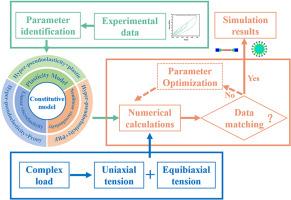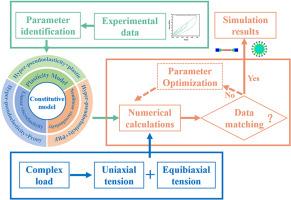Elucidating rubber loading-unloading mechanical response and permanent set using combined hyperelastic-pseudoelastic-viscoelastic/plastic model
IF 4.5
2区 化学
Q2 POLYMER SCIENCE
引用次数: 0
Abstract
Rubber materials exhibit extremely complex nonlinear mechanical responses under complex actual service conditions such as large deformation and periodic cyclic loading. Using only a hyperelastic constitutive model to describe these responses can significantly deviate from the actual response. A comprehensive understanding of material damage and permanent set behavior is imperative for guiding the design optimization and reliability evaluation of long-life, high-performance rubber components. In this paper, the uniaxial tensile recovery curve of natural rubber (NR)composites and the uniaxial and equibiaxial mode tensile recovery curves of Eucommia ulmoides gum (EUG) composites were obtained through experiments. Three constitutive model combinations (Yeoh hyperelastic model, Ogden-Roxburgh pseudoelastic model and Prony series viscoelastic model/Parallel Rheological Framework model/Plastic model) were used to fit the uniaxial tensile recovery curve of natural rubber composites. Among them, the hyperelastic-pseudoelastic-PRF (Parallel Rheological Framework) nonlinear viscoelastic model showed excellent fitting ability, and the coefficient of determination R2 of the fitting result reached 0.995. In order to expand the application scenarios of the hyperelastic-pseudoelastic-PRF model combination, it was applied to the uniaxial and equibiaxial tensile recovery deformation analysis of EUG composites. The results show that the combination of hyperelastic-pseudoelastic-PRF model can achieve high-precision prediction of the loading-unloading mechanical response of rubber under different loading modes, and the coefficient of determination R2 of the uniaxial and equibiaxial tensile recovery simulation data exceeds 0.985. By verifying the Drucker stability of the hyperelastic model, this method can provide a solution to the problem that complex nonlinear constitutive equations such as the hyperelastic-pseudoelastic-PRF model combination are difficult to converge in practical applications.


用超弹性-伪弹性-粘弹性/塑性组合模型研究橡胶的加载-卸载力学响应和永久集
橡胶材料在大变形和周期性循环载荷等复杂的实际使用条件下,表现出极其复杂的非线性力学响应。仅使用超弹性本构模型来描述这些响应会明显偏离实际响应。全面了解材料损伤和永久固定行为对于指导长寿命高性能橡胶部件的设计优化和可靠性评估至关重要。本文通过实验得到了天然橡胶(NR)复合材料的单轴拉伸恢复曲线和杜仲胶(EUG)复合材料的单轴和等双轴拉伸恢复曲线。采用3种本构模型组合(Yeoh超弹性模型、Ogden-Roxburgh伪弹性模型和proony系列粘弹性模型/平行流变框架模型/塑性模型)拟合天然橡胶复合材料的单轴拉伸恢复曲线。其中,超弹性-伪弹性- prf (Parallel Rheological Framework)非线性粘弹性模型拟合能力较好,拟合结果的决定系数R2达到0.995。为了拓展超弹性-伪弹性- prf模型组合的应用场景,将其应用于EUG复合材料的单轴和等双轴拉伸恢复变形分析。结果表明:超弹性-伪弹性- prf模型组合可实现不同加载模式下橡胶加卸载力学响应的高精度预测,单轴和等双轴拉伸恢复模拟数据的决定系数R2均大于0.985;该方法通过验证超弹性模型的Drucker稳定性,解决了实际应用中超弹性-伪弹性- prf模型组合等复杂非线性本构方程难以收敛的问题。
本文章由计算机程序翻译,如有差异,请以英文原文为准。
求助全文
约1分钟内获得全文
求助全文
来源期刊

Polymer
化学-高分子科学
CiteScore
7.90
自引率
8.70%
发文量
959
审稿时长
32 days
期刊介绍:
Polymer is an interdisciplinary journal dedicated to publishing innovative and significant advances in Polymer Physics, Chemistry and Technology. We welcome submissions on polymer hybrids, nanocomposites, characterisation and self-assembly. Polymer also publishes work on the technological application of polymers in energy and optoelectronics.
The main scope is covered but not limited to the following core areas:
Polymer Materials
Nanocomposites and hybrid nanomaterials
Polymer blends, films, fibres, networks and porous materials
Physical Characterization
Characterisation, modelling and simulation* of molecular and materials properties in bulk, solution, and thin films
Polymer Engineering
Advanced multiscale processing methods
Polymer Synthesis, Modification and Self-assembly
Including designer polymer architectures, mechanisms and kinetics, and supramolecular polymerization
Technological Applications
Polymers for energy generation and storage
Polymer membranes for separation technology
Polymers for opto- and microelectronics.
 求助内容:
求助内容: 应助结果提醒方式:
应助结果提醒方式:


